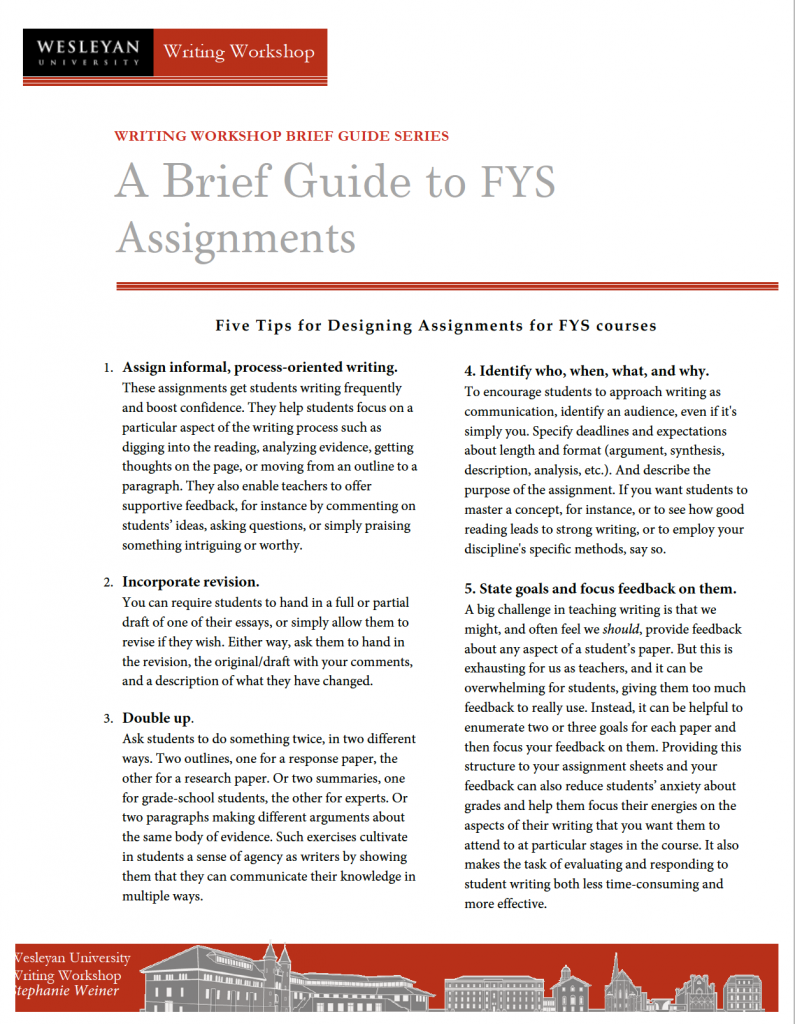This page contains some discussion about various types of writing assignments and design ideas including assignment sheets created by FYS instructors in the past. Take a look and be inspired!

Reflective Writing Assignments
As mentioned on the “Fundamentals of Writing Pedagogy” page, reflection is a key component of developing metacognition which help students transfer skillsets from your class into other writing situations. Reflective assignments take a range of forms, from formal final essay to in-class quick writes. Some examples include:
- Weekly private “Writer’s Journals” on Moodle where students reflect on what they learned during the week. Ask students to write for 15 minutes and make the journals P/F based on completion. Weekly journals develop metacognition and writing fluency by requiring regular, low-stakes reflective writing, get every student to share their learning experience without class dynamics interfering in participation, and, perhaps best of all, they are a great mechanism for seeing how students engage with your course in real time.
- Final reflective essay that describes their learning journey in your course. Let your student be the insider, here, letting you see the course from their perspective.
Scaffolding Assignments
Producing a piece of writing you are proud of takes many steps. This is especially true for academic writing which often relies on integrating sources, analyzing data, and doing research. Scaffolding writing assignments means that you break down the assignment into its parts, assigning each one separately, commenting on the work throughout, and helping students stitch the different cognitive elements together.
For example, you might assign a 10-15 page research paper that students work on throughout the course (or the latter half of the course). You can assign them specific tasks like: (1) a project proposal (2) annotated bibliography (3) outline (4) section where sources are integrated (5) a draft of the full essay (6) a polished draft.
Each element you assign should receive feedback from you or their classmates and also should earn them points. For example, perhaps the project proposal is P/F, but 5% of their total grade, as is their annotated bibliography and outline.
Writing Portfolios
Many FYS instructors encourage students to take their course Cr/U. This is supposed to encourage students to take risks in their writing without worrying about a grade. This is a great option, but there are many more ways to encourage risk, and perhaps more important, revision, without taking away the opportunity for your students to earn As. Assigning writing portfolios is one way!
Unlike writing assignments that focus on the product, writing portfolios ask students to illustrate their entire process. As such, students submit a portfolio of work along with their polished final product. This means they submit brainstorming materials, drafts, comments received from others, revision reflections, self evaluations, and possibly more.
Students earn points for the portfolio materials as well as for their polished product (perhaps 50% of points are P/F for illustrating their process and 50% of the points go towards the grade received on the final product).
Revision Reflections
If requiring writing portfolios seems like too much to handle, you might consider asking students to submit revision reflections with every polished final paper. Students can earn points (P/F for completion for example) for reflecting on their writing process and explaining the choices they made when producing their essay.
Submitting Revised Essays for Credit
In a fast-paced FYS, it can be hard to fit in days focused on revision. If this is the case for your class, you might consider offering students the opportunity to revise any of their formal writing assignments with the potential to increase their grade. For example, allow students to revise their essays for an automatic grade increase (perhaps 1/3 of a letter grade). They should submit the revised draft with an explanation of what they changed. Making the revision a set increase saves the time of grading and does not penalize students for trying to revise and not quite getting it right.
Responding to Feedback
Many students struggle to integrate feedback from one essay assignment to the next (let alone from one course to the next!). Consider assigning students this precise task. Ask them to compose a response to the instructor about their evaluation of their writing. Students can (1) summarize the feedback they received on their writing (2) cite specific comments/ideas they want to dive deeper into (3) explain how these specific moments made them think about the essay they submitted and their future writing projects. The assignment can be 5% of their total grade or more depending on how many times you ask them to do this. Making it P/F will also make it less time consuming for you to evaluate.
***
Additional Assignment Ideas
Prof. Weiner’s Generative Reading and Writing Assignment for Closely Analyzing Primary Materials

Prof. Weiner asks students to schedule ‘pitch meetings’ before finalizing their paper ideas.

